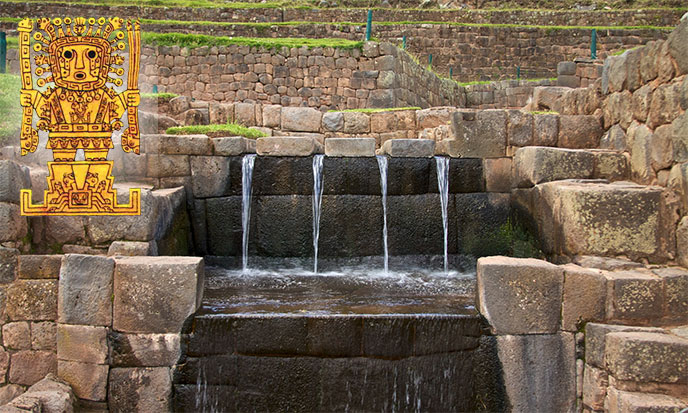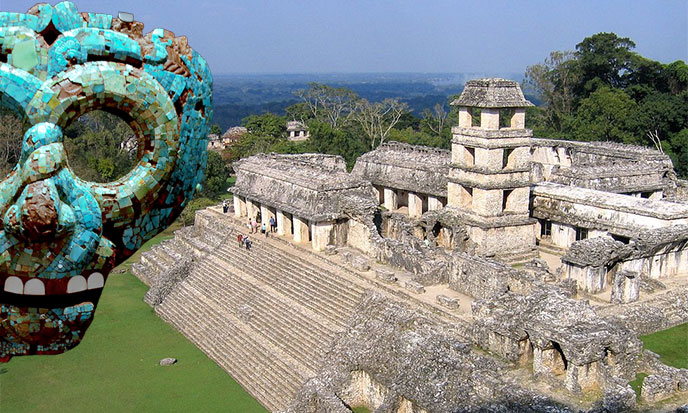![Premier plan, à gauche : Masque de Tezcatlipoca, dit le Miroir Fumant -- By Manuel de Corselas (Own work) [CC BY-SA 3.0 (http://creativecommons.org/licenses/by-sa/3.0)], via Wikimedia Commons -- arrière-plan, à droite : Chichen Itza, pyramide maya, Pixabay, libre de droits tezcatlipoca-2.0-chichen-itza-pixabay-688po](https://eden-saga.com/wp-content/uploads/tezcatlipoca-2.0-chichen-itza-pixabay-688po.jpg)
There are some areas on this planet where the oldest civilizations have prospered one after another. Meso Americafrom Greek meso, middle is a perfect example. Why so many civilizations are born there?
The term Meso-America was chosen by archaeologists and historians engaged in the study of these pre-Columbian civilizations that concentrate in Mexico and neighboring countries, Guatemala, Belize and Honduras.
Here, the Olmecs, Toltecs, Chichimecs, the Mistecs, the Aztecs and Mayans have relayed over the centuries. And this list is far from complete! Meso-America is a cradle of civilizations with a richness and a variety reminiscent of the Middle East. Or more precisely Mesopotamia. Meso again?
The middle area of the continents would be more suitable to civilization? Should we see an effect of the amazing climate theory of Montesquieu? If historians do not know why this Middle West is as fruitful as the Middle East, local people know. Their holy books make no secret about it: it all started with the feathered serpents. Interesting detail: the Sumerian legends tell the same story, that of a mysterious Serpent People… Hmm. Bridges between the two continents are so numerous that the star of discoverer of Christopher Columbus takes a blow…

The various indigenous cultures that have grown there for more than two millennia have many common features such as the existence of great cities, the same advanced agriculture based on corn, the same temples and pyramids, human sacrifices, the same worship and the famous cyclical calendar. And from the Mayas, the same handwriting. These civilizations that come and go like are therefore originating from a common source.
These cultures also share a coherent and vivacious mythology, where flying gods came after a great flood to bring peace and civilization to the indigenous peoples. These different features give unity to the Meso-American civilization, whatever the differences that can be drawn between cultures distant in time and space such as the Olmecs, the Mayas, the Toltecs, the Totonacs or the Aztecs. Take the case of the Olmecs, giving honor where honor is due. Aren’t they the first known developped people in Mesoamerica?
Archaeologists will tell you that virtually nothing is known of them, but they speak for themselves. It is true we do not know the real name of this people, and language, and religion.
But these are just details, next to this: we absolutely do not know where the Olmecs found all their expertise, from architecture to sculpture, medicine, astronomy, astronautics.
They went out of their cave wearing a buffalo-skin kilt and with their clubs they built the pyramids? It is also with their club they have learned secrets of distant stars, and even, according to U.S. astronaut Gordon Cooper, the art of spatial navigation? This people with wonder knowledge is the oldest source of the current culture … unless you stick to the official timeline … which is a crazy fake I daresay.
Eden Saga Chronology
I wish to offer my own chronology. It would go from mythical protohistory to better known history. A good way to clarify the ideas of newcomers.
-10 500: Mythical time of Quetzalcoatl or Kukulkan. A global cataclysm destroys any organized society in Central America.
The Feathered Serpents are shaping a new humanity, playing a civilizing role. They build their capital city, Teotihuacan. Follows the development of a brilliant civilization whose memory has been passed to all following civilizations. The mastery of hydraulics or that of metallurgy, mathematics, art, and many buildings ask the nagging question of the origin of such knowledge.

-8000: Around that time, the flying gods are leaving, some to Europe, others to Africa. In Mesoamerica, tribal warfare decimate the elite. The state of nature takes its course until the beginning of the historical period, around -7000.
Official History
With the El Riego period begins the official story, according to which there was nothing before that date.
-7000 -5000: Small groups of homeless people living in caves or camping outdoor harvest grain crops and plants such as avocado, peppers and squash.
-5000: Start of the period known as Coxcatlàn which sees the emergence of domestic corn. Are now being used millstones to grind the harvested plants.
-3400 -2300: Period of Abejas. Bowls and jars are shaped in stone and announce the future pottery works. The sedentarization grew and villages made of circular houses dug in the ground appear. This is the point of view of old school archaeologists, who believe these basic villages to be the first manmade habitats. They forget the great megalithic city of Teotihuacan … Or rather, they chose to date it much closer to us. Within half a century, many dates of the protohistoric period have been brought closer in the name of likelihood.
Egyptologists are making the same dirty trick with the so-called pyramids of the Fourth Dynasty,which are actually Predynastic.
Those who believe in creation according to the letter of the Bible sometimes show an obtuse mind. Their opponents, draped in the dignity of a false science, aren’t much better. Those believe in evolution can not understand the human saga that obeys physics: no evolution, but involution. Entropy is increasing, while deteriorates.
Overall, there is no progress, but inevitable decline … Everything that lives eventually grow old and die, civilizations as individuals. We know it but we forget it. But scientists, themselves, how can they forget the point of building a theory based on false premises: the theory of evolution! If Darwin is excusable not to have known the principles of thermodynamics, the neo-Darwinians are not. I would even say that they are excused for nothing.

-2300 -1500: Purron period that marks the end of the Archaic Period of the Tehuacan Valley. Exceptional conditions have facilitated research in this area but it is likely that the cultivation of corn appeared elsewhere during this long period particularly archaic in the lowlands where its traces were not kept.
-1200 -400: Development phase of the Olmec culture, illustrated by numerous archaeological sites:
La Venta, San Lorenzo Tenochtitlan and Laguna de los Cerros, in the lowlands of Vera Cruz and Jalisco. The construction of large sanctuaries, the use of jade and serpentine, the realization of the famous colossal heads characterize this culture.
The Olmecs have often been designated as the Sumerians of the New World. This is certainly the mother civilization of which all others are derived, by natural descent. But the question remains, crucial: what civilization was the mother of the Olmecs? Where do their science, their art, their architecture come from?
-500: Beginnings of the Zapotec civilization at Monte Alban where Mesoamericans may have invented writing and the calendar. Unless they have inherited it of a lost civilization, thesis supported by the new archaeologists, and which appears to be justified. The figurines found in large numbers in Jalisco and Nayarit, near the Pacific coast of western Mexico date back to the same period.
Here starts the better known and less contested history of Mesoamerica.
As I said, there are two distinct sources of information in this chronology: those describing the protohistory up to -7000, and those concerning the official history, after that date. The points of divergence between official history and the new archeology relate to the protohistory, this blurred time at the edge of our shared knowledge: ie the sum of knowledge on which there is only one school of thought.

In this shadowy fringe, in these marches of the realm of history, scouts circulate. They bring back the golden apples, similar to those of the Hesperides. Pathé Diagne is one of them. According to him, Mesoamerica was once a branch of Black Africa. Like everything else on that continent, for that matter … I was very impressed like him by the enigma of the giant Negroid heads of the Olmec people. I have followed this trail of the black African presence in America.
But Diagne is a fount of knowledge. He goes much further.


